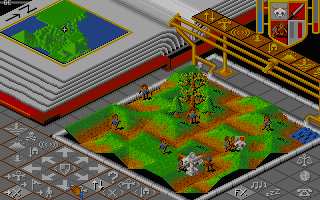So I need a game design based around a heightfield/billboard engine.
First, let’s be explicit. What do I mean by a heightfield/billboard engine?
I mean a base world defined by terrain, and that terrain defined by a heightfield. Other models may sit on top of this heightfield, but the heightfield is the “ground” of the world.
Units in this world will be done with billboarded sprites. A “billboarded” sprite is one that is actually rendered as a 3D object, but is always rotated so that it faces the player.
Lots and lots and lots of games have been made with this system, and some of them have been truly great, like…
Populous (It counts, although you couldn’t rotate the map):

Powermonger

Dungeon Keeper

Syndicate Wars

Myth: The Fallen Lords and Myth II: Soulblighter

You can see that this engine style lends itself to real-time games with strategic elements (although none of the above are “real-time strategy” games as that phrase is defined today).
I definitely want my game to be real-time. I want the player to have buildings and units. I want the game to be fantasy-themed or mythology-themed. I also want the player to be able to raise and lower terrain, and I want that to be an actual game mechanic. But I’m not sure if I want the player to be able to directly control units. And I’m not sure if I want resource gathering.
Standard real-time-strategy: The player has direct control over resource gathering, building creation, unit creation and unit direction.
Populous: There are no resources. The player has indirect control over building creation and unit creation, and unit direction.
Powermonger: Some resources can be gathered directly. Others simply control what you can build in each city. The player has indirect control over building and unit creation, direct control over special item creation, and direct control over his army (but not villagers).
Dungeon Keeper: The player has direct control over buildings, resource gathering and resource collecting units, but only indirect control over fighting unit creation and direction.
Syndicate: Syndicate is more of an action game than a real-time strategy game.
Myth: There are no resources. There are no buildings. The player has direct control over his units.
Notice that Powermonger and Dungeon Keeper are practically mirrors – in Powermonger, the player indirectly controls the creation of his army, but directly controls the army itself. In Dungeon Keeper, the player has more direct control over the creation of his army (though not total control) but has little control over the army itself (he can drop his monsters directly over the enemy, but if they don’t want to fight they’ll just walk away).
Hmmm…this is going to take some pondering.

You know me: as far as I’m concerned the closer you get to Syndicate the better…
I was a big fan of Myth in theory. I hate resource gathering. Building things is nice, in as far as it gives you bonuses to your troops. But Myth boiled real-time strategy down to its table top gaming roots. It was like playing Warhammer, you’ve got a 500 point army, now pick the best mix of units and go and fight it out.
And with all that said, I do like making buildings. I don’t like making buildings and managing resources to build an army and fight. It feels like the damn game is commanding me to play a broken version of Sim City at the same time as playing a real-time Warhammer. I still think it’s overcomplicated but it took off and now they’re all done that way.
When you know more about what it is you like about these games specifically, then a design will start to form. I, for instance, am drafting a design as I type what elements of RTS games I like. Also, you might like what we did for our original War of the Ring design before the project got awarded to Liquid. It was simplified on city construction and resource gathering in a way I dug.
From somebody who’s played Myth for several years, I am, surprise, strongly opposed to unit-building games. The problem is not in the idea, it’s that to be competitive at any level in Starcraft, for instance, you have to be able to click bloody, bloody fast just to be able to produce a big enough army… and THEN you get to fight. By that time, if one player or the other has significantly out-clicked the other, then that battle is already over, and there’s nothing interesting left for the players to do outside of playing out an inevitable loss/win. Boring.
Kids in South Korea actually practice for weeks just to be able to get their clicking speeds up. I could go on, but the point is, as a player, what do you want to play? Do you want to play a game that rewards CLICKCLCRKLCLICKETYCLICKLCLICKLCLCKLICK… or do you want to play a game that rewards _how well_ you click, such as in Myth, where the units basically do the work of throwing, walking, and even basic attacking. All you need to do, as the player, is to guide those units into making the right decisions: taking the flag or going for the kill; take this hill or that ridge; archs hit the ghols while dwarves go for melee.
I think a resource-building game could work as long as the player-clicking requirement was knocked out of the picture. Starcraft would be way more interesting with way less effort if the resource system was overhauled so that the tedious crap was done for you, so players could focus more on what armies they’re making and where/how they’re attacking, instead of constantly being bothered by production.
All valid points! Perhaps you should read this later post where I come to very much the same conclusions.